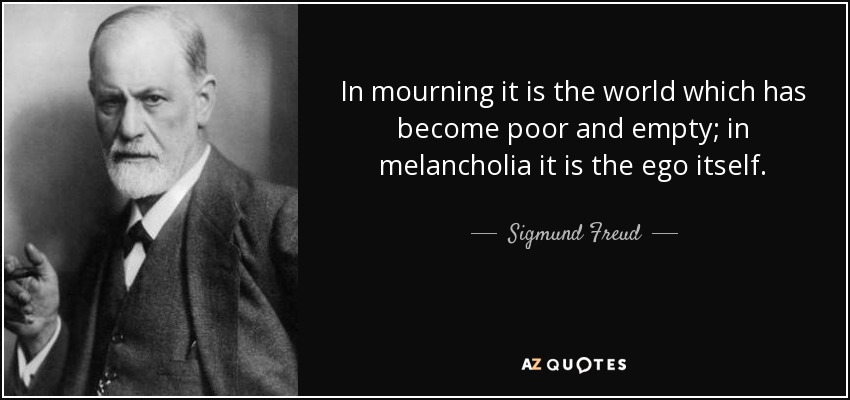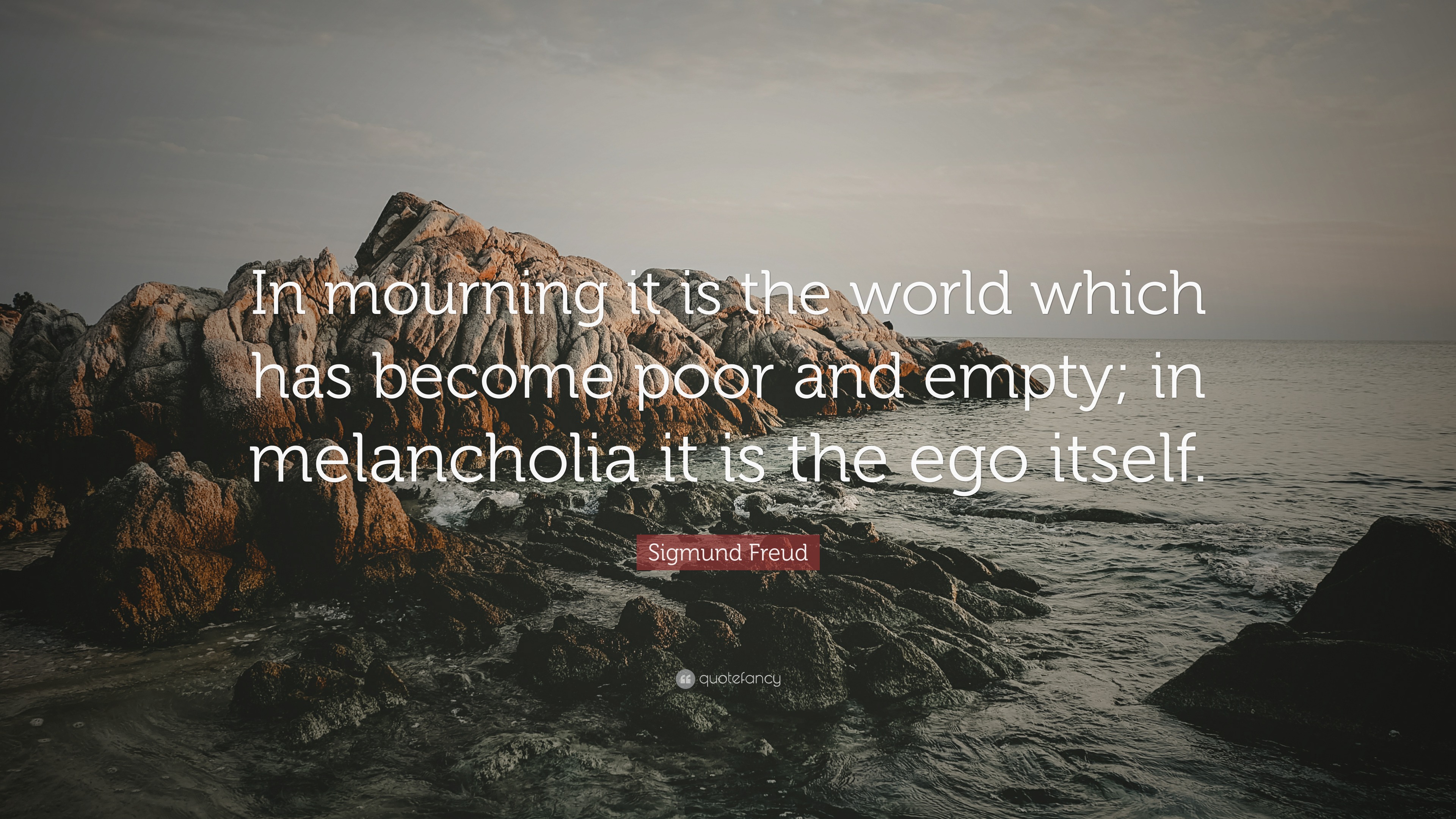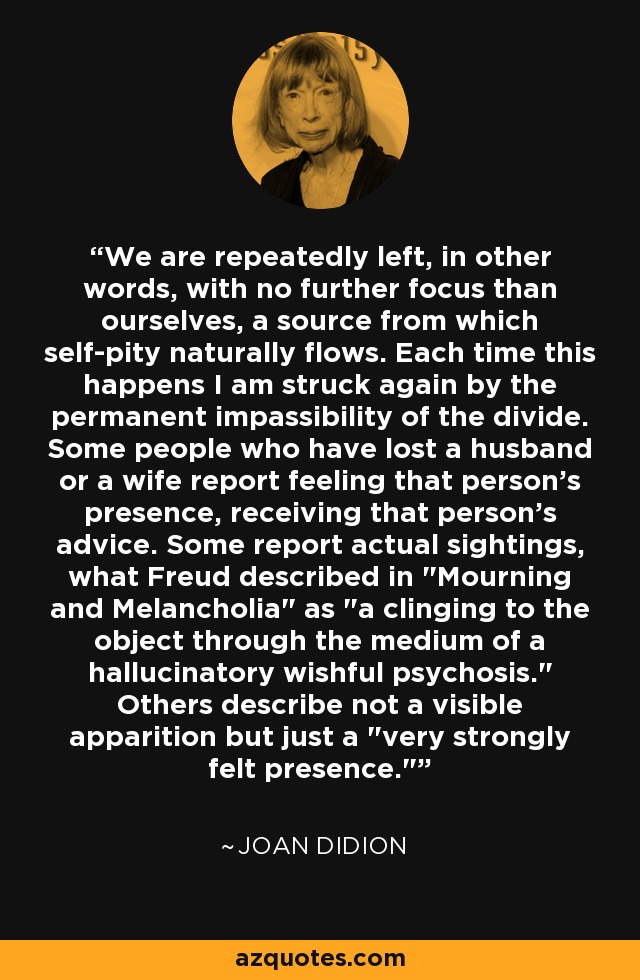Freud mourning and melancholia citation information
Home » Trending » Freud mourning and melancholia citation informationYour Freud mourning and melancholia citation images are available. Freud mourning and melancholia citation are a topic that is being searched for and liked by netizens today. You can Get the Freud mourning and melancholia citation files here. Download all royalty-free photos and vectors.
If you’re searching for freud mourning and melancholia citation pictures information linked to the freud mourning and melancholia citation interest, you have pay a visit to the ideal site. Our site frequently provides you with suggestions for refferencing the maximum quality video and image content, please kindly hunt and locate more informative video content and graphics that match your interests.
Freud Mourning And Melancholia Citation. 4 in “mourning and melancholy” freud writes that “mourning is regularly the reaction to the loss of a loved person, or to the loss of some abstraction which has taken the place of one, such as one’s country, liberty, an ideal, and so on” (234). He distanced himself from the psychiatric perspective he had once adopted in draft g of the fliess papers (1950a [1895]), while emphasizing that the concept of melancholia had many aspects (especially somatic ones) that he would not examine. Mourning and melancholia is freud’s (1917) first, and fundamental contribution to the psychoanalytic understanding of normal and pathological mourning, the psychopathology of major affective disorders and the psychodynamic determinants of depression. �it is well worth notice that, although mourning involves grave departures from the normal attitude to life, it never occurs to us to regard it as a pathological condition and refer to it medical treatment.
 (PDF) Images on the void An enquiry into the nature of From researchgate.net
(PDF) Images on the void An enquiry into the nature of From researchgate.net
Identity, “identology” and world religions. 4 in “mourning and melancholy” freud writes that “mourning is regularly the reaction to the loss of a loved person, or to the loss of some abstraction which has taken the place of one, such as one’s country, liberty, an ideal, and so on” (234). This model informs mourning and melancholia (1917), in which freud argued that mourning comes to a decisive end when the subject severs its emotional. In �mourning and melancholia� , freud compared the experience of mourning with the pathological state of depression: Identity, “identology” and world religions. In this short, rich article, freud described the essence of melancholia by comparing it to the normal affect of mourning.
Freud�s mourning theory has been criticized for assuming a model of subjectivity based on a strongly bounded form of individuation.
In �mourning and melancholia� , freud compared the experience of mourning with the pathological state of depression: Identity, “identology” and world religions. Mourning and melancholia is freud’s (1917) first, and fundamental contribution to the psychoanalytic understanding of normal and pathological mourning, the psychopathology of major affective disorders and the psychodynamic determinants of depression. Has been cited by the following article: This model informs mourning and melancholia (1917), in which freud argued that mourning comes to a decisive end when the subject severs its emotional. Melancholia from mourning in which, he says, ‘the disturbance of self regard is absent’ (freud, 1957:244).
 Source: pinterest.com
Source: pinterest.com
Concept of peer pressure often cited as a factor in the initiation of drug use. Melancholia from mourning in which, he says, ‘the disturbance of self regard is absent’ (freud, 1957:244). In �mourning and melancholia� , freud compared the experience of mourning with the pathological state of depression: In his 1917 essay “mourning and melancholy”, freud recognizes two mutually exclusive responses to loss — mourning [trauer] and melancholia [melancholie]. Mourning and melancholia is freud’s (1917) first, and fundamental contribution to the psychoanalytic understanding of normal and pathological mourning, the psychopathology of major affective disorders and the psychodynamic determinants of depression.
 Source: researchgate.net
Source: researchgate.net
The distinction often made is that mourning occurs after the death of a loved one while in melancholia the object of love does not qualify as irretrievably lost. Whereas in melancholy “the object has not perhaps actually died, but has been lost as an object of love […] Has been cited by the following article: At the same time, it also marks major developments in. Teaching freud’s “mourning and melancholia“.
 Source: researchgate.net
Source: researchgate.net
4 in “mourning and melancholy” freud writes that “mourning is regularly the reaction to the loss of a loved person, or to the loss of some abstraction which has taken the place of one, such as one’s country, liberty, an ideal, and so on” (234). Freud�s mourning theory has been criticized for assuming a model of subjectivity based on a strongly bounded form of individuation. Article citations more>> freud, s. Mourning and melancholia is freud’s (1917) first, and fundamental contribution to the psychoanalytic understanding of normal and pathological mourning, the psychopathology of major affective disorders and the psychodynamic determinants of depression. At the same time, it also marks major developments in.
 Source: azquotes.com
Source: azquotes.com
Mourning and melancholia is freud’s (1917) first, and fundamental contribution to the psychoanalytic understanding of normal and pathological mourning, the psychopathology of major affective disorders and the psychodynamic determinants of depression. Identity, “identology” and world religions. Freud�s mourning theory has been criticized for assuming a model of subjectivity based on a strongly bounded form of individuation. In mourning and melancholia, written in 1915, freud proposed a coherent and convincing theory of the nature and origin of melancholic states and offered startling new insights into the growth of. �it is well worth notice that, although mourning involves grave departures from the normal attitude to life, it never occurs to us to regard it as a pathological condition and refer to it medical treatment.
 Source: fashionessay.x.fc2.com
Source: fashionessay.x.fc2.com
�it is well worth notice that, although mourning involves grave departures from the normal attitude to life, it never occurs to us to regard it as a pathological condition and refer to it medical treatment. Article citations more>> freud, s. Mourning and melancholia is freud’s (1917) first, and fundamental contribution to the psychoanalytic understanding of normal and pathological mourning, the psychopathology of major affective disorders and the psychodynamic determinants of depression. In �mourning and melancholia� , freud compared the experience of mourning with the pathological state of depression: 4 in “mourning and melancholy” freud writes that “mourning is regularly the reaction to the loss of a loved person, or to the loss of some abstraction which has taken the place of one, such as one’s country, liberty, an ideal, and so on” (234).
 Source: scielo.br
Source: scielo.br
This model informs “mourning and melancholia” (1917), in which freud argued that mourning comes to a decisive end when the subject severs its emotional attachment to the lost one and reinvests the free libido in a new. Advanced search include citations tables: Freud�s mourning theory has been criticized for assuming a model of subjectivity based on a strongly bounded form of individuation. In �mourning and melancholia� , freud compared the experience of mourning with the pathological state of depression: In (1917) by s freud add to metacart.
 Source: researchgate.net
Source: researchgate.net
In �mourning and melancholia� , freud compared the experience of mourning with the pathological state of depression: Identity, “identology” and world religions. In �mourning and melancholia� , freud compared the experience of mourning with the pathological state of depression: In �mourning and melancholia� , freud compared the experience of mourning with the pathological state of depression: Has been cited by the following article:
 Source: quotefancy.com
Source: quotefancy.com
Whereas in melancholy “the object has not perhaps actually died, but has been lost as an object of love […] Freud�s mourning theory has been criticized for assuming a model of subjectivity based on a strongly bounded form of individuation. Both melancholia and mourning are triggered by the same thing, that is, by loss. In �mourning and melancholia� , freud compared the experience of mourning with the pathological state of depression: 4 in “mourning and melancholy” freud writes that “mourning is regularly the reaction to the loss of a loved person, or to the loss of some abstraction which has taken the place of one, such as one’s country, liberty, an ideal, and so on” (234).
 Source: researchgate.net
Source: researchgate.net
�it is well worth notice that, although mourning involves grave departures from the normal attitude to life, it never occurs to us to regard it as a pathological condition and refer to it medical treatment. My heart into my mouth. Has been cited by the following article: 4 in “mourning and melancholy” freud writes that “mourning is regularly the reaction to the loss of a loved person, or to the loss of some abstraction which has taken the place of one, such as one’s country, liberty, an ideal, and so on” (234). In (1917) by s freud add to metacart.
 Source: researchgate.net
Source: researchgate.net
In (1917) by s freud add to metacart. Identity, “identology” and world religions. Melancholia from mourning in which, he says, ‘the disturbance of self regard is absent’ (freud, 1957:244). In mourning and melancholia, written in 1915, freud proposed a coherent and convincing theory of the nature and origin of melancholic states and offered startling new insights into the growth of. In �mourning and melancholia� , freud compared the experience of mourning with the pathological state of depression:
 Source: researchgate.net
Source: researchgate.net
In �mourning and melancholia� , freud compared the experience of mourning with the pathological state of depression: He distanced himself from the psychiatric perspective he had once adopted in draft g of the fliess papers (1950a [1895]), while emphasizing that the concept of melancholia had many aspects (especially somatic ones) that he would not examine. My heart into my mouth. Whereas in melancholy “the object has not perhaps actually died, but has been lost as an object of love […] Mourning and melancholia is freud’s (1917) first, and fundamental contribution to the psychoanalytic understanding of normal and pathological mourning, the psychopathology of major affective disorders and the psychodynamic determinants of depression.
 Source: pinterest.com
Source: pinterest.com
Teaching freud’s “mourning and melancholia“. In mourning and melancholia, written in 1915, freud proposed a coherent and convincing theory of the nature and origin of melancholic states and offered startling new insights into the growth of. Teaching freud’s “mourning and melancholia“. Has been cited by the following article: In his 1917 essay “mourning and melancholy”, freud recognizes two mutually exclusive responses to loss — mourning [trauer] and melancholia [melancholie].
 Source: researchgate.net
Source: researchgate.net
At the same time, it also marks major developments in. Article citations more>> freud, s. In this short, rich article, freud described the essence of melancholia by comparing it to the normal affect of mourning. This model informs “mourning and melancholia” (1917), in which freud argued that mourning comes to a decisive end when the subject severs its emotional attachment to the lost one and reinvests the free libido in a new. Identity, “identology” and world religions.
 Source: exploringyourmind.com
Source: exploringyourmind.com
In �mourning and melancholia� , freud compared the experience of mourning with the pathological state of depression: Both melancholia and mourning are triggered by the same thing, that is, by loss. Identity, “identology” and world religions. Identity, “identology” and world religions. This model informs mourning and melancholia (1917), in which freud argued that mourning comes to a decisive end when the subject severs its emotional.
![[324] Freud Citation Depression QuoteFamous [324] Freud Citation Depression QuoteFamous](https://www.frontiersin.org/files/Articles/36851/fpsyg-04-00158-HTML/image_m/fpsyg-04-00158-g001.jpg) Source: quotefamouss.blogspot.com
Source: quotefamouss.blogspot.com
He distanced himself from the psychiatric perspective he had once adopted in draft g of the fliess papers (1950a [1895]), while emphasizing that the concept of melancholia had many aspects (especially somatic ones) that he would not examine. He distanced himself from the psychiatric perspective he had once adopted in draft g of the fliess papers (1950a [1895]), while emphasizing that the concept of melancholia had many aspects (especially somatic ones) that he would not examine. Has been cited by the following article: �it is well worth notice that, although mourning involves grave departures from the normal attitude to life, it never occurs to us to regard it as a pathological condition and refer to it medical treatment. Article citations more>> freud, s.
 Source: searchforhappiness.eu
Source: searchforhappiness.eu
The distinction often made is that mourning occurs after the death of a loved one while in melancholia the object of love does not qualify as irretrievably lost. My heart into my mouth. In �mourning and melancholia� , freud compared the experience of mourning with the pathological state of depression: Both melancholia and mourning are triggered by the same thing, that is, by loss. Has been cited by the following article:
 Source: pinterest.com
Source: pinterest.com
�it is well worth notice that, although mourning involves grave departures from the normal attitude to life, it never occurs to us to regard it as a pathological condition and refer to it medical treatment. The distinction often made is that mourning occurs after the death of a loved one while in melancholia the object of love does not qualify as irretrievably lost. �it is well worth notice that, although mourning involves grave departures from the normal attitude to life, it never occurs to us to regard it as a pathological condition and refer to it medical treatment. Freud�s mourning theory has been criticized for assuming a model of subjectivity based on a strongly bounded form of individuation. 4 in “mourning and melancholy” freud writes that “mourning is regularly the reaction to the loss of a loved person, or to the loss of some abstraction which has taken the place of one, such as one’s country, liberty, an ideal, and so on” (234).
 Source: azquotes.com
Source: azquotes.com
�it is well worth notice that, although mourning involves grave departures from the normal attitude to life, it never occurs to us to regard it as a pathological condition and refer to it medical treatment. Identity, “identology” and world religions. Mourning and melancholia is freud’s (1917) first, and fundamental contribution to the psychoanalytic understanding of normal and pathological mourning, the psychopathology of major affective disorders and the psychodynamic determinants of depression. In �mourning and melancholia� , freud compared the experience of mourning with the pathological state of depression: Has been cited by the following article:
This site is an open community for users to do submittion their favorite wallpapers on the internet, all images or pictures in this website are for personal wallpaper use only, it is stricly prohibited to use this wallpaper for commercial purposes, if you are the author and find this image is shared without your permission, please kindly raise a DMCA report to Us.
If you find this site adventageous, please support us by sharing this posts to your own social media accounts like Facebook, Instagram and so on or you can also save this blog page with the title freud mourning and melancholia citation by using Ctrl + D for devices a laptop with a Windows operating system or Command + D for laptops with an Apple operating system. If you use a smartphone, you can also use the drawer menu of the browser you are using. Whether it’s a Windows, Mac, iOS or Android operating system, you will still be able to bookmark this website.
Category
Related By Category
- Easybib chicago citation information
- Doi to apa citation machine information
- Citation x poh information
- Cpl kyle carpenter medal of honor citation information
- Goethe citation dieu information
- Exact citation apa information
- Citation une impatience information
- Fitzgerald way out there blue citation information
- Contre le racisme citation information
- Friedrich nietzsche citaat grot information